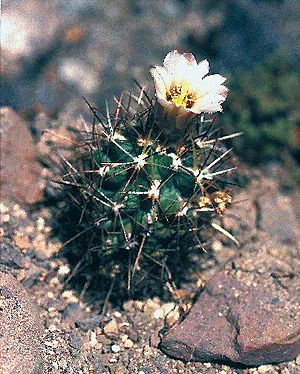Wright's little barrel cactus facts for kids
Quick facts for kids Wright's little barrel cactus |
|
|---|---|
 |
|
| Conservation status | |
| Scientific classification | |
| Kingdom: | |
| (unranked): | |
| (unranked): | |
| (unranked): | |
| Order: | |
| Family: | |
| Subfamily: | |
| Tribe: |
Cacteae
|
| Genus: | |
| Species: |
S. wrightiae
|
| Binomial name | |
| Sclerocactus wrightiae L.D.Benson
|
|
The Sclerocactus wrightiae is a special kind of cactus. People often call it Wright's little barrel cactus or Wright's fishhook cactus. It is very rare.
A scientist named Dr. Lyman Benson gave this cactus its name. He named it after Dorde Wright Woodruff, an expert on cacti in North America. Ms. Woodruff first found this cactus in 1961. She showed it to Dr. Benson, and they worked together on other Sclerocactus plants later on.
Contents
Where Does Wright's Fishhook Cactus Live?
This cactus only grows in Utah, a state in the United States. It is found in just a few counties there: Emery, Sevier, Wayne, and Garfield. You can see it in places like Capitol Reef National Park and the San Rafael Swell.
The Wright's fishhook cactus is an endangered species. This means it is at high risk of disappearing forever. The United States government officially listed it as endangered on October 11, 1979.
What Kind of Soil Does It Need?
This cactus likes to grow in areas with shrubs. It needs a special type of soil. The soil is usually fine or sandy. It also has many small pieces scattered on top, like pebbles, gravel, and old fossil oyster shells.
An important part of its home is the cryptobiotic crust. This is a living layer on top of the soil, made of tiny plants and fungi. The cactus cannot grow in places where this crust has been damaged or removed.
What Does Wright's Fishhook Cactus Look Like?
The stems of the Sclerocactus wrightiae are usually 4 to 12 centimeters tall. They can be round and flat, egg-shaped, or short and cylinder-shaped. They do not grow very tall.
The flowers of this cactus are 2 to 3.5 centimeters long. They can be yellowish, white, or pink. The tiny threads inside the flowers, called filaments, are red-violet. Before the flowers open, their buds are reddish-brown and round. Just before they bloom, the buds get longer and become pointed.
Why Is This Cactus Endangered?
Many things threaten the survival of the Wright's fishhook cactus. Its home is often harmed by activities like looking for oil and gas. Mining for things like coal, gypsum, and uranium also causes damage.
Animals like cows and sheep can also hurt the plants. They might step on them or pull them out of the ground. People using off-road vehicles can also damage the cactus's habitat.
Sadly, some people illegally dig up these cacti to sell them. This is called poaching and it is a big problem.
Natural Threats to the Cactus
The cactus also faces dangers from nature. A type of beetle called Moneilema semipunctatum likes to eat it. This problem has become worse because of changes in the climate.
Small animals can also eat the cactus. These include the Ord's kangaroo rat (Dipodomys ordii) and the White-tailed antelope squirrel (Ammospermophilus leucurus).
See also
 In Spanish: Sclerocactus wrightiae para niños
In Spanish: Sclerocactus wrightiae para niños


